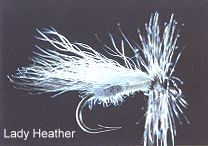|
Tying Instructions:

1. Tie down hackle fibers for a tail.

2. Dub a thick butt of gray muskrat fibers.

3. Dub or wrap a thin body of cream fur.

4. Bind down a wing of white calf tail.

5. Tie in a dun hackle and a grizzly hackle; wrap them together.
6. Whip finish.
Fishing the Lady Heather:
Even through the worst years of drought the Bitterroot has fished
well. The Montana Department of Fish, Wildlife and Parks has purchased
water from Painted Rocks Reservoir and these releases keep the Bitterroot
flowing well in mid-summer.
Ed brown, Glen Tryan, and I floated the stretch above Hamilton and
proved what everyone says, "The Root is a moody river."
Two weeks ago Green Drakes and Brown Drakes were all over the water.
Browns and rainbows were in the prime lies and schools of whitefish were
spread out over the flats. The rise went on all afternoon.
This morning the weather looked perfect, the same solid overcast, not dark
but medium gray, that produced great dry fly fishing during the Drake hatches.
There were no bugs of any kind on the water today, however, and only a
few sporadic rises.
At first a Gray Wulff did as well as anything, pulling up fish as we drifted and
cast to banks. Ed was in the back seat, throwing accurately, with enough slack
to get good drifts right on the foam line, and was catching a few trout (best a
17-inch brown.) Glen wasn't doing as well, but his problems had nothing to
do with the fly. Fishing from a boat was new to him, and he was casting too
straight, his line devoid of slack on the water. He started changing patterns every
ten minutes, looking for magic that didn't exist.
Whe we stopped to wade a long riffle, Glen fished beautifully, all of his
confusion in the boat gone, but he was still switching flies. Even after
catching a fish, he would snip off the successful pattern.
"What are you doing?" I asked.
"Playing around," he said.
Here was a man after my own heart. The least I could do was give him a few
more patterns to play with on a slow fishing day. I handed him a few Lady
Heathers with the batch of flies.
The storm was building, the clouds piling up thicker in the river valley. All
this gloom apparently perked up the trout for dry flies, both Glen and Ed
yelling with each hookup. I was working subsurface, dead drifting a Prince
nymph on the bottom, terrorizing the whitefish and occasionally catching
a nice trout, but the fishing stayed the same for me.
Ed called me down to take a picture of a fat, 19-inch brown. The trout
had a Lady Heather in her mouth and Ed pointed to it, "This has been
taking fish for the last half hour."
"Have you been changing flies every time you catch something?"
"Heck, no, I got this from Glen and I'm not giving it back." ~ Gary LaFontaine
Credits: From Gary LaFontaine's Trout Flies - Proven Patterns,
Published by Greycliff Publishing, Helena Montana. We sincerely
thank them for use permission.
|






